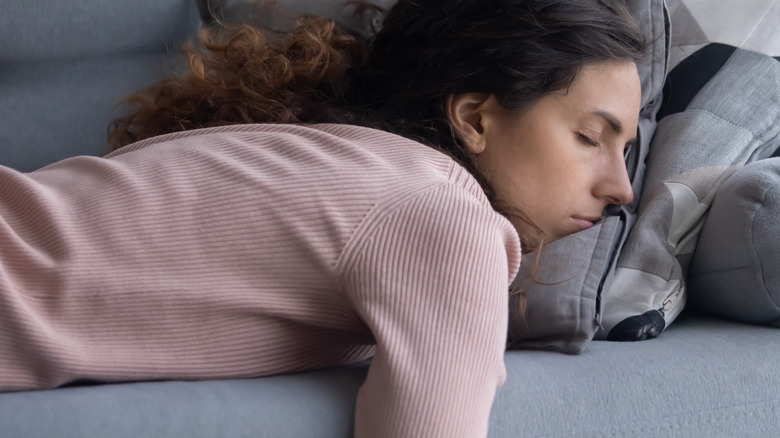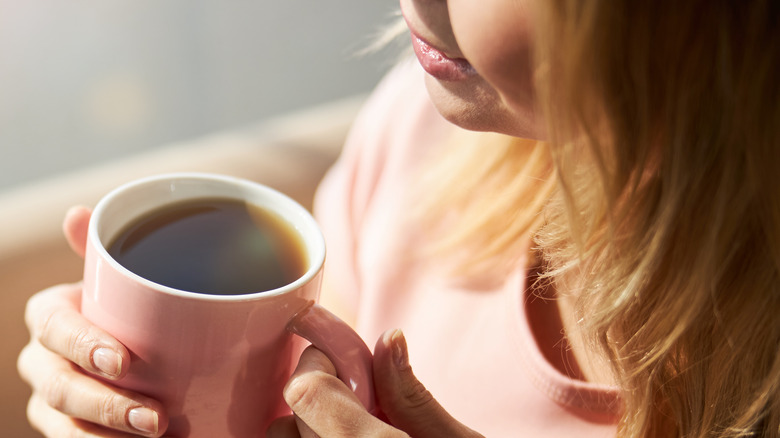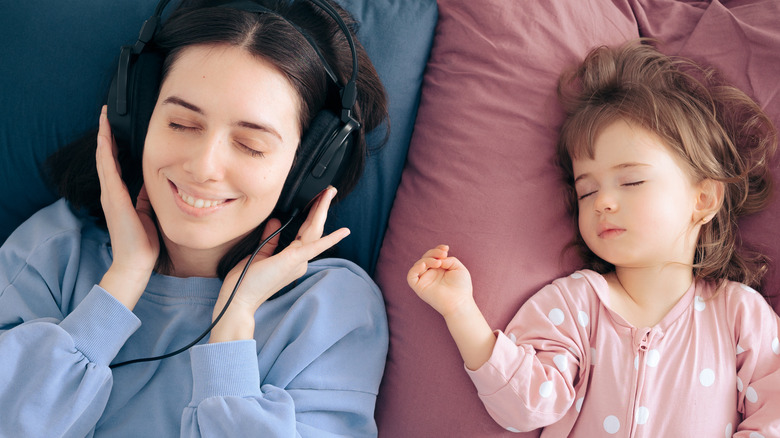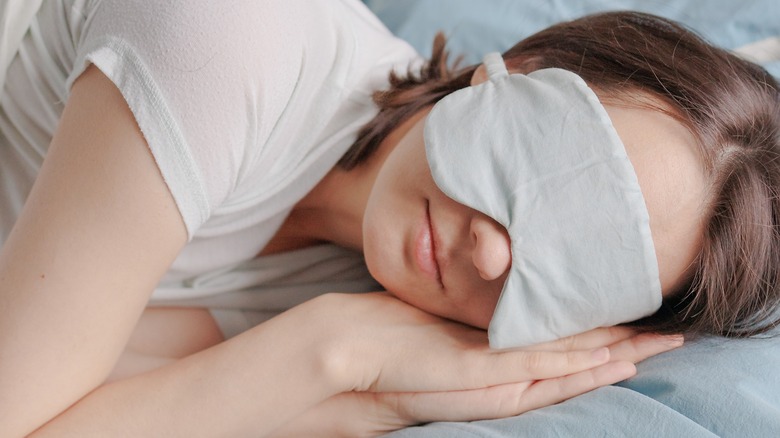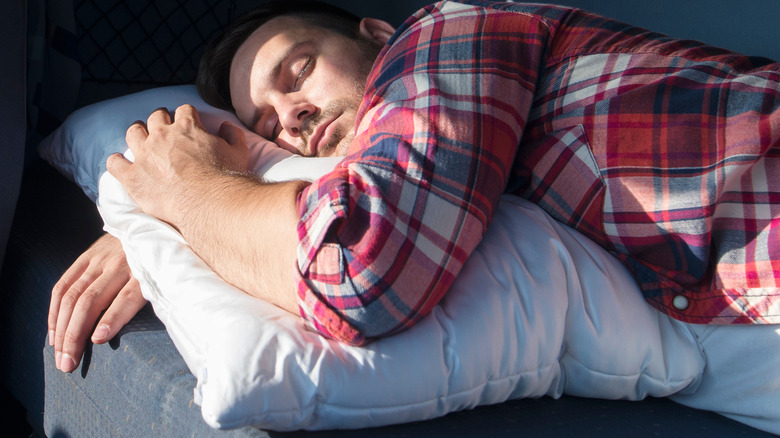Make The Most Of Your Midday Nap With These Tips
As comedian Carrie Snow famously said, "No day is so bad it can't be fixed with a nap." That's true for both babies and adults. In the early afternoon, we tend to feel a bit drowsy and sleepy, which is a common response to our circadian rhythm, a natural process that regulates our sleep-wake cycle. Midday fatigue, if not addressed, can make it hard for us to focus and cause mood swings. So to get a grip on the midday slump, get some brief shut-eye.
Scientific evidence concludes that a short nap can reduce fatigue, restore alertness, and lift our mood. Brief afternoon naps can also enhance cognitive performance by boosting your ability to memorize things, connect the dots, and make sound judgment calls, a study published in BMJ shows. In addition, a well-timed midday nap is a pick-me-up, allowing you to reset and return to your daily activities with more clarity and vigor. That said, how much mileage you can get out of your midday naps depends on how you go about it. For instance, too much napping or resting your forehead on the table during a nap can cause you to wake up with a headache and even more drowsiness. So to make the most of your midday nap, follow these tips.
Get some caffeine before your nap
Paradoxical as it sounds, caffeine can make your snooze more enjoyable and productive. A 2003 study polling 10 participants published in the journal Clinical Neurophysiology found that those consuming 200 mg of caffeine before taking a nap reported seeing improvements in counteracting drowsiness and better work productivity when compared to non-caffeine nappers. A similar conclusion was made in another research in the journal Psychophysiology polling 12 sleepy drivers. Per the study, those who consumed 200 mg of caffeine prior to a 15-minute nap before a 2-hour drive in a car simulator felt 91% less sleepy behind the wheel than those who didn't.
Healthline also suggests that coffee naps can boost energy more than coffee or napping alone because caffeine begins to work the instant you awaken after a brief nap. To get the most out of your midday nap, drink one or two cups of unsweetened coffee right before your nap. The reason is that foods or beverages high in added sugar close to bedtime can make it hard to fall asleep. Keep in mind that excessive caffeine consumption can trigger a feeling of restlessness and muscle tremors. For most people, 400 mg of caffeine per day, or approximately four cups of coffee, is regarded as a safe dose.
Keep your siesta short
Too much of anything good is bad, and that's the case for naps. Therapist Gin Lali recommends Sunday Edit readers keep their midday snooze between 20 and 30 minutes and set a timer for 30 minutes. "20 minutes is perfect," she says, "allow five minutes either side of that to settle in and to revive yourself so set a timer for 30 minutes." The longer your power nap is, the more likely you wake up feeling dazed to the point of sluggishness, and your nighttime sleep is also affected.
A daytime nap doesn't count as a substitute for a nightly sleep. Therefore, those with trouble sleeping at night should be extra cautious about keeping their daytime shut-eye consistently brief. Besides, a 2015 meta-analysis in the journal SLEEP finds that daytime naps that last longer than 60 minutes per day have been linked with a higher risk of heart disease. Restricting your siesta to 20 or 30 minutes each day will leave you feeling energized and raring to go. Beyond that, and you'll wish you'd taken no nap at all.
Take a nap in the early afternoon
Timing is everything. And it can't be any truer for midday naps. If you schedule a nap during mid or late afternoon time, you might end up being wide awake throughout the night. To avoid letting your nap interfere with your nightly rest, Mayo Clinic suggests getting a brief siesta before 3 PM. However, your napping schedule should depend on your daily life habits or work arrangements. If you work night shifts, Sleepio recommends you take a nap for up to three hours to lessen your sleep deficit.
In case you find it difficult to catch some Zs, try at least 15 to 20 minutes of napping before getting to work. Keep in mind that a siesta that lasts longer than 30 to 40 minutes will cause your body to fall into a deep sleep. While a deep sleep will help eliminate sleep debt, it will take you about an hour after waking up to ease back into your routine and get ready for work. Therefore, time your nap right to avoid being late or dazed at work. After waking up or during the first half of your shift, you can use coffee or other energy drinks to rid yourself of sleep inertia and boost your attention.
Nap in a dark and quiet place
Another thing to remember before taking a nap is location, location, location. If you want to get an undisturbed and productive nap, find yourself a dark and quiet place. Lighting, regardless of the sources, has considerable influence on circadian rhythm, melatonin production, and sleep cycles. According to research published in the journal SLEEP, people who were exposed to light while asleep slept for roughly 10 minutes less each night, contributing to more sleep debt. These people also reported post-sleep fatigue, daytime drowsiness, and poorer productivity.
By the same token, noise has also been shown to disrupt sleep and is even linked to insomnia, poor heart health, and high blood pressure, Connect Hearing warns. To get a healthy nap, try to find a place where no light and noise can penetrate. If it's impossible to cancel out all the midday light and noise, consider wearing an eye mask and ear plugs to help you sleep easier.
Nap in a horizontal position
Some office people can get so busy and worn out during midday that they often doze off sitting upright, sometimes with their head resting on a desk. Make no mistake; you can get a nap in just any position that suits you. However, SELF recommends lying down as you nap because a horizontal position makes it easier for you to ease into sleep. However, too much comfort might make you nap for longer than you should. That's why sleep psychologist Lauren Broch (via Healthline) recommends napping on a couch or a homey chair instead of in your bed.
Numerous studies have shown that daytime naps have a host of benefits for our physical and mental well-being. For example, a well-timed nap can relieve stress, promote weight loss, reduce risks of heart attacks, and boost alertness. If your schedule permits, carve out 20 to 30 minutes in the middle of the day to switch off your mind, turn off all devices, and get some brief rest. Over time, you'll find that incorporating power naps into your shifts can help improve your productivity, inspire your creativity, and return to work with more energy.
